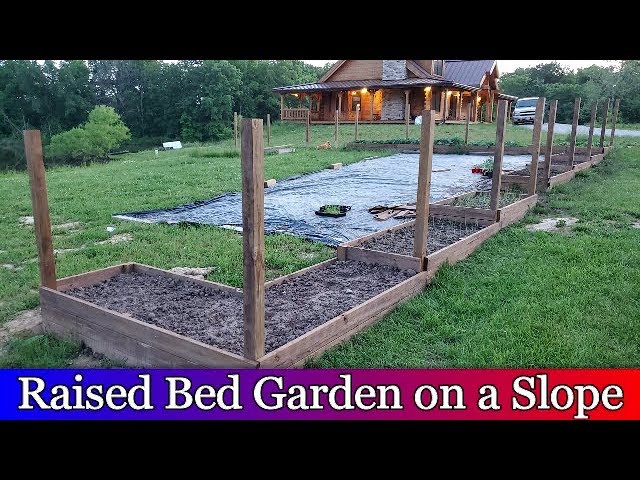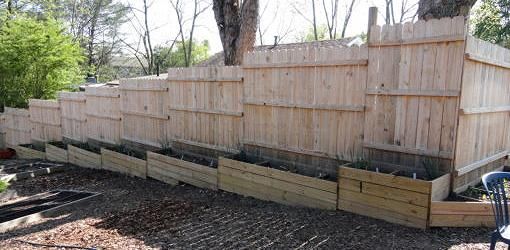Hey there! If you’re someone who’s passionate about fences and looking for a comprehensive resource to expand your knowledge on the subject, then you’re in luck! At “Fencedude.com,” a blog website dedicated to all things fences, we strive to provide engaging and reliable content that covers various aspects of fences. From different types, sizes, shapes, and materials to determining which fence is suitable for specific needs or requirements, we’ve got you covered. Our goal is to educate readers on the characteristics, advantages, and considerations of each fence type, ensuring that you can make informed decisions when selecting and installing fences. So, let’s dive into the role of fences in sloped garden beds and planters and explore the world of fences together!
The Role of Fences in Sloped Garden Beds and Planters
When it comes to creating visually appealing and functional outdoor spaces, sloped garden beds and planters can add a unique dimension to your landscape. However, managing and maintaining these areas can present a variety of challenges, particularly when it comes to soil erosion, drainage, and aesthetic considerations. This is where fences can play a crucial role. In this article, we will explore the importance of fences in sloped garden beds and planters, the various benefits they offer, different types suitable for these areas, factors to consider when choosing fences, installation techniques, maintenance tips, and how fences can enhance both aesthetics and functionality.
1. Introduction to Sloped Garden Beds and Planters
1.1 What are Sloped Garden Beds?
Sloped garden beds refer to raised planting areas that are positioned on a sloping surface. These beds are designed to create level spaces for gardening and landscaping, allowing for improved water drainage and utilization of otherwise unusable land.
1.2 What are Sloped Planters?
Sloped planters are similar to garden beds, but they typically incorporate containers or pots that are placed on a slope instead of planting directly in the ground. This allows for more flexibility in terms of plant arrangement and design.
1.3 Importance of Fencing in Sloped Garden Beds and Planters
Fencing plays a vital role in sloped garden beds and planters as it helps address specific challenges associated with these areas. Fences can prevent soil erosion, create terraced sections for planting, establish boundaries, enhance privacy and security, and add decorative elements to the landscape.
2. Benefits of Fences in Sloped Garden Beds and Planters
2.1 Preventing Soil Erosion
One of the primary benefits of using fences in sloped garden beds and planters is their ability to prevent soil erosion. By strategically placing fences along slopes, you can effectively reduce the risk of soil runoff, which can lead to garden loss and water pollution.
2.2 Creating Terraced Sections for Planting
Fences can also aid in the creation of terraced sections within sloped garden beds and planters. By installing fences at different levels, you can separate and support different plant species, ensuring optimal growing conditions and efficient use of space.
2.3 Establishing Boundaries and Protecting Plants
In sloped garden beds and planters, fences help establish boundaries and prevent plants from spreading or encroaching on neighboring areas. They provide a clear separation between different planting zones or property boundaries, ensuring a well-organized and manageable garden space.
2.4 Enhancing Privacy and Security
Fences are often used to enhance privacy and security in outdoor spaces, including sloped garden beds and planters. By enclosing these areas with fences, you can create a more secluded and protected environment, shielding your garden from prying eyes and potential intruders.
2.5 Adding Decorative Elements and Aesthetics
Fences can also serve as decorative elements in sloped garden beds and planters, adding visual interest and enhancing the overall aesthetic appeal of the landscape. Choosing fences with attractive designs or incorporating vines and plants can create a stunning and harmonious outdoor environment.
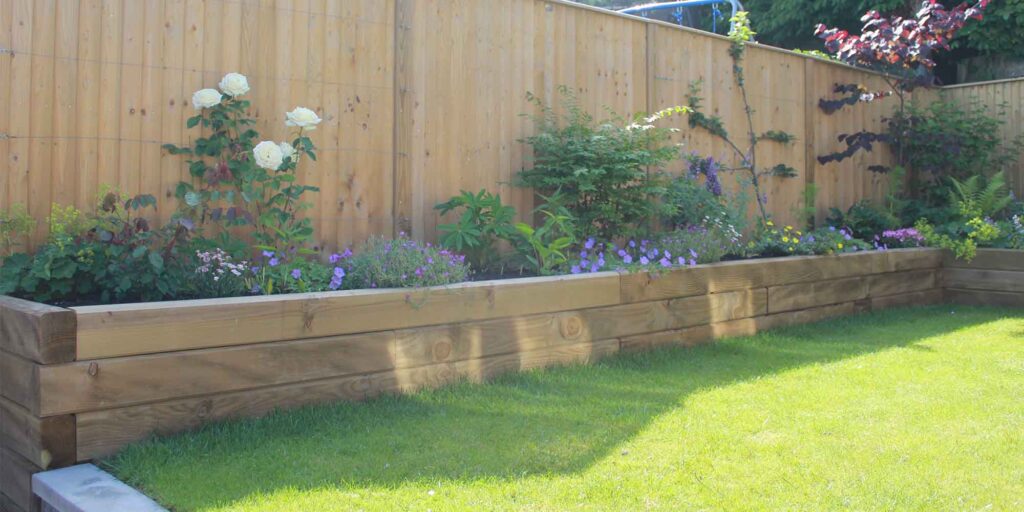
3. Types of Fences Suitable for Sloped Garden Beds and Planters
3.1 Wooden Fences
Wooden fences are a popular choice for sloped garden beds and planters due to their natural appearance and versatility. They can be easily customized to fit various sloping angles and offer a rustic and organic charm to the landscape.
3.2 Metal Fences
Metal fences, such as wrought iron or aluminum, are known for their durability and strength. These fences can provide a sense of elegance and sophistication to sloped garden beds and planters while offering reliable protection and security.
3.3 Vinyl Fences
Vinyl fences are low-maintenance and highly durable, making them suitable for sloped garden beds and planters. They are available in various styles and colors, allowing for customization to match the desired aesthetic.
3.4 Wire Fences
Wire fences, such as woven wire or mesh panels, are commonly used in sloped garden beds and planters to create a physical barrier while providing visibility. These fences offer effective boundary delineation without obstructing the view.
3.5 Chain-link Fences
Chain-link fences are affordable and versatile options for sloped garden beds and planters. They come in different heights and gauges, providing both security and visibility while accommodating the linear contours of the slope.
3.6 Composite Fences
Composite fences combine the benefits of different materials, such as wood and plastic, into a durable and low-maintenance option. They are resistant to rot, fading, and pests, making them suitable for sloped garden beds and planters.
4. Factors to Consider when Choosing Fences for Sloped Garden Beds and Planters
4.1 Slope Gradient
The slope gradient of your garden bed or planter will determine the type of fence that is suitable. Steeper slopes may require fences that can be adjusted or contoured to match the incline, while gradual slopes may allow for a wider variety of fence options.
4.2 Soil Type and Condition
Consider the type and condition of your soil when choosing fences for sloped garden beds and planters. Different materials may interact differently with the soil, and factors such as drainage and erosion potential should be taken into account.
4.3 Water Drainage
Proper water drainage is crucial in sloped garden beds and planters to prevent water buildup and soil erosion. Choose fences that do not impede water flow or consider incorporating drainage solutions alongside the fence installation.
4.4 Climate and Weather Conditions
The climate and weather conditions of your area play a significant role in determining the suitable fence material. Consider factors such as temperature fluctuations, precipitation levels, and exposure to sun or wind when choosing fences that can withstand these conditions.
4.5 Budget and Cost
Budget and cost considerations are important when selecting fences for sloped garden beds and planters. Different fence materials and designs come with varying costs, and it’s essential to find a balance between your budget and the desired functionality and aesthetics.
4.6 Personal Preferences and Aesthetics
Personal preferences and aesthetics should also guide your choice of fences in sloped garden beds and planters. Consider the overall style, theme, and existing elements in your landscape, ensuring that the fence complements and enhances the overall visual appeal.
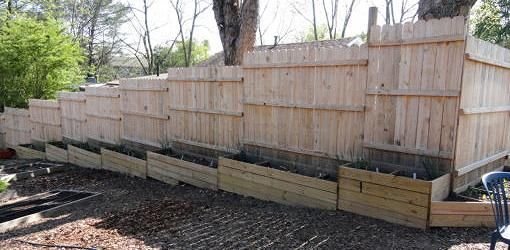
5. Installation Techniques for Fences in Sloped Garden Beds and Planters
5.1 Assessing the Slope and Preparing the Site
Before installing fences in sloped garden beds and planters, assess the slope and plan the installation accordingly. Remove any obstacles, level the ground as much as possible, and consider any necessary slope modifications or reinforcements.
5.2 Choosing the Right Fence Posts and Supports
Selecting the appropriate fence posts and supports is crucial in ensuring the stability and durability of fences in sloped garden beds and planters. Depending on the slope gradient, you may need to choose posts and supports that can be adjusted or angled to match the contour.
5.3 Adjusting Fence Panels for Uneven Surfaces
In sloped garden beds and planters, fence panels often need to be adjusted to fit uneven surfaces. Cut panels to the desired size, create angles if necessary, and ensure a snug fit against the slope. Use brackets or connectors to secure the panels in place.
5.4 Securing the Fence and Ensuring Stability
To ensure the fence’s stability, it is crucial to secure it properly in the sloped garden beds and planters. Use sturdy anchors, brackets, or concrete footings to anchor the fence posts and prevent movement or instability.
5.5 Installing Gates and Access Points
Consider the placement of gates and access points when installing fences in sloped garden beds and planters. Ensure that gates can be opened and closed smoothly on the slope, and add additional support or reinforcement if needed.
6. Maintenance Tips for Fences in Sloped Garden Beds and Planters
6.1 Regular Cleaning and Inspection
To keep fences in sloped garden beds and planters in good condition, perform regular cleaning and inspection. Remove dirt, debris, and any plant overgrowth that may affect the fence’s stability or aesthetics. Inspect for any signs of damage or wear.
6.2 Repairing Damaged Parts
Address any damaged or worn-out parts of the fence promptly. Repair broken panels, loose posts, or damaged hardware to ensure the structural integrity of the fence. Replace any irreparable components as needed.
6.3 Treating and Protecting Wood
If you have wooden fences in your sloped garden beds and planters, proper treatment and protection are crucial to extend their lifespan. Apply weather-resistant coatings, stains, or sealants to protect the wood from moisture, UV rays, and pests.
6.4 Preventing Rust and Corrosion
For metal fences, preventing rust and corrosion is essential to maintain their appearance and structural integrity. Regularly inspect metal surfaces, treat any signs of rust, and consider using protective coatings or paints to prevent further corrosion.
6.5 Repainting or Staining
To refresh the appearance of fences in sloped garden beds and planters, consider repainting or staining them periodically. This not only enhances their aesthetics but also provides additional protection against weathering and wear.
6.6 Pruning Plants Near Fences
If you have plants or vines growing near the fences in your sloped garden beds and planters, ensure that they are regularly pruned and trimmed. Overgrown vegetation can put strain on the fence and potentially cause damage if left unattended.
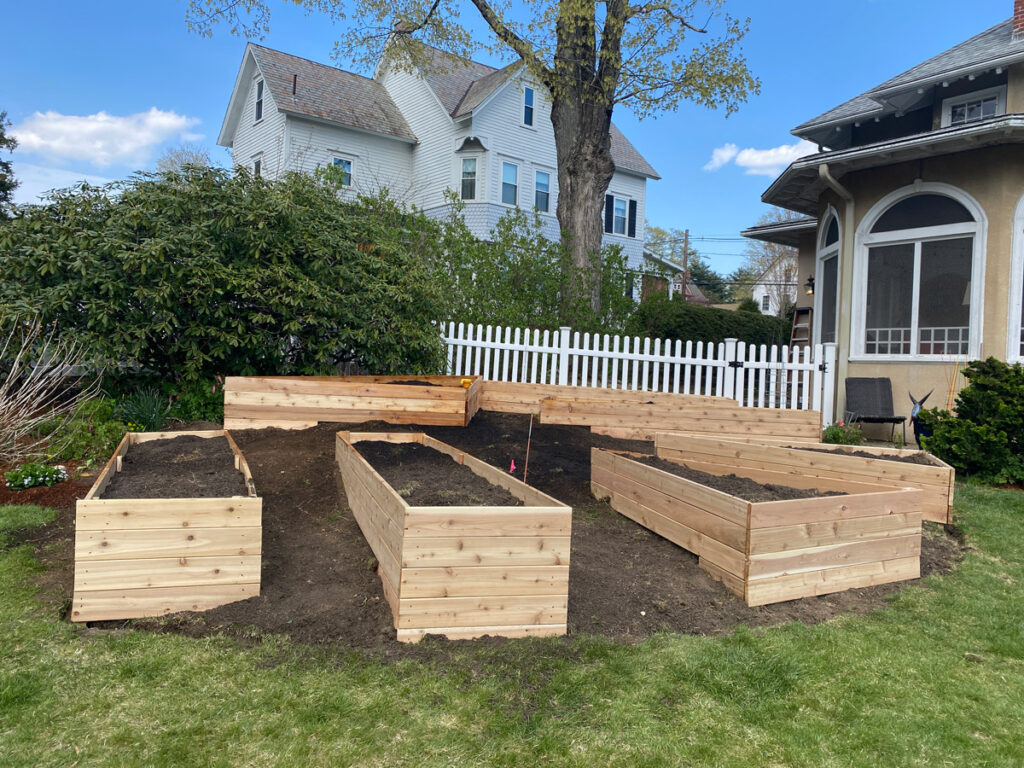
7. Enhancing Aesthetics with Fences in Sloped Garden Beds and Planters
7.1 Choosing Fence Styles and Designs
When it comes to enhancing aesthetics, selecting the right fence styles and designs is crucial. Consider the overall theme of your landscape, architectural elements, and personal preferences to choose fences that complement and elevate the visual appeal of sloped garden beds and planters.
7.2 Incorporating Plants and Vines
Incorporating plants and vines can soften the appearance of fences in sloped garden beds and planters, integrating them harmoniously into the landscape. Choose plants that are suitable for the local climate and can thrive in the specific conditions of your garden bed or planter.
7.3 Adding Decorative Elements
To further enhance the aesthetics of fences in sloped garden beds and planters, consider adding decorative elements. This can include decorative caps, finials, lattice panels, and other accents that add visual interest and character to the fence.
7.4 Utilizing Lighting and Pathways
Illuminate your sloped garden beds and planters by incorporating lighting fixtures along the fences. Use strategic placement of pathway lights or install solar-powered lights to create an enchanting ambiance and ensure safety during nighttime.
8. Using Fences for Erosion Control in Sloped Garden Beds and Planters
8.1 The Importance of Erosion Control
Erosion control is crucial in sloped garden beds and planters to prevent soil loss and maintain the integrity of the landscape. Fences can play a significant role in slowing down water runoff and holding soil in place, reducing the risk of erosion.
8.2 Building Retaining Walls
Retaining walls can effectively control erosion in sloped garden beds and planters. These walls can be constructed using various materials, such as timber, concrete blocks, or natural stone, and are designed to redistribute the weight of the soil and retain it in place.
8.3 Installing Wire or Fence Netting
Wire or fence netting can be installed along the slope to provide additional support and prevent soil erosion. These materials act as a barrier, holding the soil in place while still allowing water to pass through freely.
8.4 Creating Terraces and Stone Steps
Another effective erosion control technique is creating terraces or stone steps within the sloped garden beds and planters. By dividing the slope into smaller, level sections, you can control water runoff and minimize soil erosion.
8.5 Implementing Water Management Techniques
Incorporating water management techniques can significantly contribute to erosion control in sloped garden beds and planters. Install swales, drainage ditches, or perforated pipes to redirect water away from vulnerable areas and properly manage water flow.
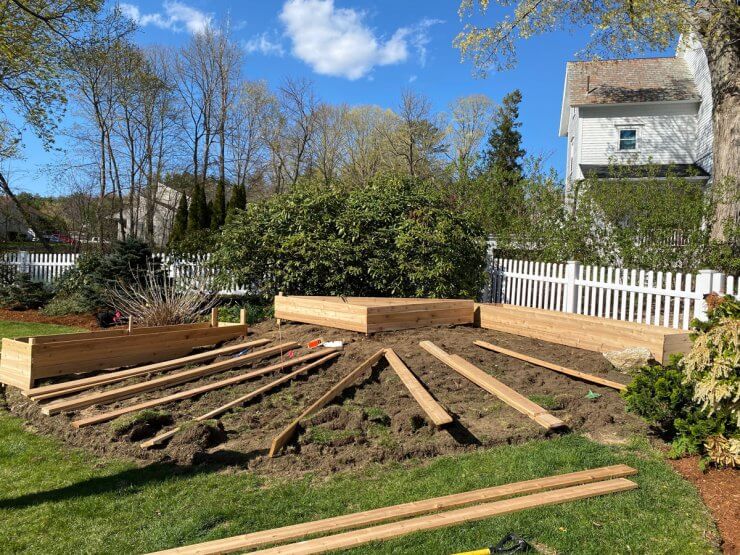
9. Addressing Drainage Issues with Fences in Sloped Garden Beds and Planters
9.1 Understanding Drainage Problems
Drainage problems can arise in sloped garden beds and planters, affecting plant health and overall garden functionality. Poor drainage can result in waterlogged soil, erosion, and increased moisture levels, which can be detrimental to plant growth.
9.2 Installing French Drains or Subsurface Drainage
French drains or subsurface drainage systems can effectively address drainage issues in sloped garden beds and planters. These systems collect excess water and redirect it away from the area, ensuring proper water drainage and preventing waterlogging.
9.3 Using Perforated Pipe Systems
Perforated pipe systems can be installed alongside fences in sloped garden beds and planters to manage water drainage. These pipes allow water to seep through and be redirected to a suitable outlet, ensuring proper soil moisture and preventing water accumulation.
9.4 Constructing Swales and Berms
Swales and berms are excellent options for managing drainage in sloped garden beds and planters. These features divert water away from vulnerable areas, allowing it to slowly infiltrate the soil, promoting natural drainage and preventing erosion.
9.5 Implementing Rain Gardens
Rain gardens can be created in sloped garden beds and planters to improve drainage and utilize excess water. By selecting plants that are tolerant of excessive moisture and designing a depression that collects and filters rainwater, rain gardens can help mitigate drainage issues.
10. Safety Considerations when Using Fences in Sloped Garden Beds and Planters
10.1 Choosing Fence Heights and Gaps
Consider safety when selecting fence heights and gaps in sloped garden beds and planters. Ensure that the fence is tall enough to prevent unauthorized access and that the gaps between the fence components are narrow enough to deter pets or children from getting through.
10.2 Using Child and Pet Safety Features
If you have children or pets, additional safety features should be incorporated into the fences in sloped garden beds and planters. This may include adding mesh panels, locks, or self-closing gates to prevent accidental entrances or exits.
10.3 Checking for Stability and Secure Attachment
Regularly check the stability and secure attachment of fences in sloped garden beds and planters to ensure that they remain structurally sound and safe. Replace any loose or damaged components, tighten screws or bolts if necessary, and ensure that the posts are securely anchored.
10.4 Inspecting for Sharp Edges and Protruding Parts
Inspect fences in sloped garden beds and planters for any sharp edges or protruding parts that could cause injury. Sand down or cover any sharp edges and ensure that all fence components are smooth and safe to touch.
10.5 Ensuring Proper Signage and Warnings
If your sloped garden beds and planters are near areas that require special precautions, such as swimming pools or hazardous areas, ensure that proper signage and warnings are in place. This helps prevent accidents and informs individuals of potential risks.
Common Questions on Fences:
- Can fences really prevent soil erosion in sloped garden beds and planters?
- Are all fence types suitable for sloped garden beds and planters?
- How do I choose the right fence height for safety in sloped areas?
- What are some durable materials for fences in sloped garden beds and planters?
- Are wire fences effective for boundary delineation in sloped areas?
- What maintenance tasks should I perform regularly for fences in sloped garden beds and planters?
- How can I enhance the aesthetics of fences in sloped garden beds and planters?
- What are some erosion control techniques I can implement with fences in sloped areas?
- How do I address drainage issues in sloped garden beds and planters with fences?
- What safety features should I consider when using fences in sloped areas?
| Question | Answer |
|---|---|
| Can fences really prevent soil erosion in sloped garden beds and planters? | Yes, fences can effectively prevent soil erosion by slowing down water runoff, holding the soil in place, and creating terraced sections that minimize erosion. |
| Are all fence types suitable for sloped garden beds and planters? | Not all fence types are suitable for sloped areas. It’s important to consider the slope gradient, soil conditions, and other factors when choosing the most suitable fence for your sloped garden beds and planters. |
| How do I choose the right fence height for safety in sloped areas? | When choosing the right fence height for safety in sloped areas, consider the purpose of the fence and the potential risks. Ensure that the fence is tall enough to prevent unauthorized access and that the gaps between components are narrow enough to deter pets or children from getting through. |
| What are some durable materials for fences in sloped garden beds and planters? | Some durable materials for fences in sloped areas include metal fences (such as wrought iron or aluminum), vinyl fences, and composite fences. These materials are known for their strength, durability, and resistance to weathering. |
| Are wire fences effective for boundary delineation in sloped areas? | Yes, wire fences, such as woven wire or mesh panels, are commonly used for boundary delineation in sloped garden beds and planters. They provide effective separation and visibility while ensuring proper drainage and preventing soil erosion. |
| What maintenance tasks should I perform regularly for fences in sloped garden beds and planters? | Regular cleaning, inspection for damage, repair of any worn-out parts, treating and protecting wood (if applicable), preventing rust and corrosion (for metal fences), and repainting or staining are common maintenance tasks for fences in sloped areas. |
| How can I enhance the aesthetics of fences in sloped garden beds and planters? | You can enhance the aesthetics of fences in sloped areas by choosing fence styles and designs that complement the overall landscape, incorporating plants and vines to soften the fence’s appearance, adding decorative elements such as caps or lattice panels, and utilizing lighting and pathways to create an enchanting ambiance. |
| What are some erosion control techniques I can implement with fences in sloped areas? | Some erosion control techniques you can implement with fences in sloped areas include building retaining walls, installing wire or fence netting, creating terraces and stone steps, and implementing water management techniques such as swales or drainage systems. |
| How do I address drainage issues in sloped garden beds and planters with fences? | To address drainage issues, you can install French drains or subsurface drainage systems, use perforated pipe systems, construct swales or berms, and implement rain gardens. These techniques help manage water flow and prevent waterlogging in sloped areas. |
| What safety features should I consider when using fences in sloped areas? | When using fences in sloped areas, consider factors such as fence height and gaps to ensure safety, incorporate child and pet safety features such as mesh panels or self-closing gates, regularly inspect for stability and secure attachment, check for sharp edges or protruding parts, and ensure proper signage and warnings if needed. |
